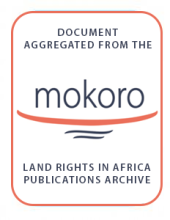Land Library
Welcome to the Land Portal Library. Explore our vast collection of open-access resources (over 74,000) including reports, journal articles, research papers, peer-reviewed publications, legal documents, videos and much more.
/ library resources
Showing items 1 through 9 of 561.On 5 March 2021 the Namibian Ministry of Land Reform issued 988 land holder titles to nine associations in Freedom Square;an informal settlement in Gobabis municipality;with an additional 122 to be printed in due course.
A review of a book on land in Kenya published in 2020 by Boydell and Brewer Ltd. The reviewer offers a detailed analysis and discussion of the 8 chapters of this 224-page book.
This article argues that while we know that the demand for land and natural resources has significantly accelerated in the last decade;it remains very difficult to gauge the exact size of the land rush. Many studies that look into how much land is affected give vastly diverging numbers.
Africa’s Catholic bishops have criticized the appropriation of land;natural resources and other economic assets by private companies and called on national governments to show greater concern for local community rights and needs.
Environmental regulation is an important means of restraining enterprises and protecting the environment. Rationalization of environmental regulatory policies can promote high-quality regional economic development.
Coupled with rapid urbanization and urban expansion, the spatial relationship between transportation development and land use has gained growing interest among researchers and policy makers.
Alpine pastures and meadows are agroecosystems of biological, cultural-historical, and economic importance that are undergoing profound imbalances and which are in a rapid decline due to changes in management and/or abandonment.
Landscape connectivity is a critical component of dynamic processes that link the structure and function of networks at the landscape scale.
The urban sprawl process of Ulaanbaatar has changed dramatically due to population growth. Ulaanbaatar city land management master plan defined the settlement zone area suitable for living as 33,698 ha.


